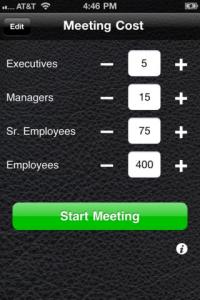
For many of us, meetings are both the burden and badge of honor. I hear it all the time that I can’t get any “real” work done because I’m back to back to back.
Running from one meeting to the next, I can barely keep up with email (another burden/bragging point – I’ve got over 1,000,000 emails in my inbox).
I think the reason that we are in so many meetings is that there are a few false assumptions about meetings. Also, before I start, a lot of the advice I’ve gotten on meetings is from Manager Tools (ran by Mark Horstman and Mike Auzenne). One of my favorite podcasts that I recommend you listen to. I’ve been a faithful listener for at least four years now.

First, I believe that people see meetings as “free”. They are not – they are actually one of the most expensive things that can happen on a project. If you do the ROI of a meeting and think about the cost of the people in the meeting tied to their salaries – a meeting can rack up an amazing amount of cost quickly. Here’s an app that can help you calculate it.
Second, people see meetings as where decisions get made. But I rarely see this happen because many meetings don’t have well-defined agendas and many are used for discussions not decisions. They get sidetracked and people run out of time before a decision can be made.
So how to do you make your meetings more efficient and effective?
Before you agree to go to a meeting – make sure you absolutely without a doubt have to be in the meeting. If the decision can be made without you then don’t go. You have too much work (digging out of email hell – I’ll have a post on that as well) to do and another meeting isn’t going to help it get done.
Schedule work in your calendar before people can grab it for meetings. I used to schedule work blocks (half hour blocks of time to focus on real work, email, etc…). I would recommend less than three meetings a day if you can do that. I know, haha.
If you’ve decided that you need a decision on something and the project can’t move forward without it, then schedule the meeting. But before you do schedule it, there are several characteristics of a really good effective meetings to consider.
Best Run Meetings Characteristics:
- Set Meetings to 45 minutes or shorter
- Any meeting that can get done in an hour, can be done in 45 minutes. We tend to take the time we have to talk things through. 15 minutes is going to get filled with useless banter.
- This also allows people to get to another meeting if they have to. (I don’t know how many times decision makers have left the room to get to another meeting – highly frustrating).
- Put together a solid agenda
- Here’s an example
Welcome and Meeting Purpose
Item One
Decision To Be Made
Item Two
Decision To Be Made
Follow-Up and Next Steps
Adjourn
- Without an agenda and an idea of the decision that needs to be made, a meeting is just a meaningless discussion. There’s no execution and you’ve just spent a lot of company resources to decide nothing.
- Prioritize agenda items starting with the most important
- Don’t lead with small items because you think those will be the easiest to discuss and solve. In fact, if it’s small maybe it shouldn’t make the agenda.
- Set a time limit to every agenda item
- So if we look at our agenda again
Welcome and Purpose – 10:00
Item One – 10:05
Decision To Be Made – 10:25
Item Two – 10:30
Decision To Be Made – 10:35
Follow-Up and Next Steps – 10:40
Adjourn – 10:45
- Then you need to be diligent about following the clock and stopping anything that looks to deride the schedule. It’s not that you need to be crazy but many meetings without clock watching wander around and fall into disarray.
- Must end with solution per item (next step)
- There is always a solution to every item. If there wasn’t then why did we subject ourselves to another meeting? 🙂 If people can’t agree on the solution, then maybe it was too early to be having a meeting about the subject. Meetings are there for solutions not discussions. Brainstorming and discussions are not meetings and should be tried differently.
- Parking lot anything that goes off agenda
- If you have a time limit on your items then you will quickly realize when things are going off-track. The meeting facilitator needs to be weary of anything that can take away from the meeting and should parking lot those discussions for a future time.
- Start on time ALWAYS
- When meetings are back to back to back, people sometimes give a grace period. This sets a horrible precedent and shows the people in the room that have made the effort to be there, that their time is not as important. BTW, leaving a meeting early does the same time.
- If you start on time, people will start showing up on time.
- Always have a scribe
- I am a proponent of everyone taking good notes – I, myself, do my own notes in Evernote (love that software)
- But for people that can’t do notes and be engaged in the conversation, you should have a scribe that will share the notes with everyone after. With as many meetings as we have every day and week, it’s wonder anyone can remember anything.
- Give your full attention
- If you are distracted by your technology, then turn it off or put it away.
- If you use it to take notes, that’s great but just make sure you are taking notes. Shut off your notifications. I believe that we get distracted by our technology because we are back to back to back.
- Sit upright and face the speaker
- Posture means everything in a meeting and if you are slouching, or looking around aimlessly or disengaged, the rest of the room notices and causes them to disengage.
What are your favorite tips and tricks for running effective meetings? I would love to add them.
Leave a Reply